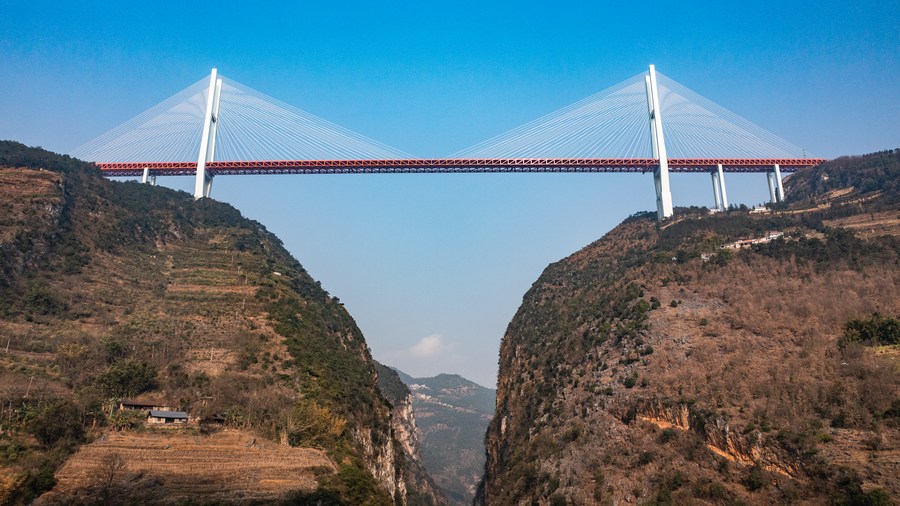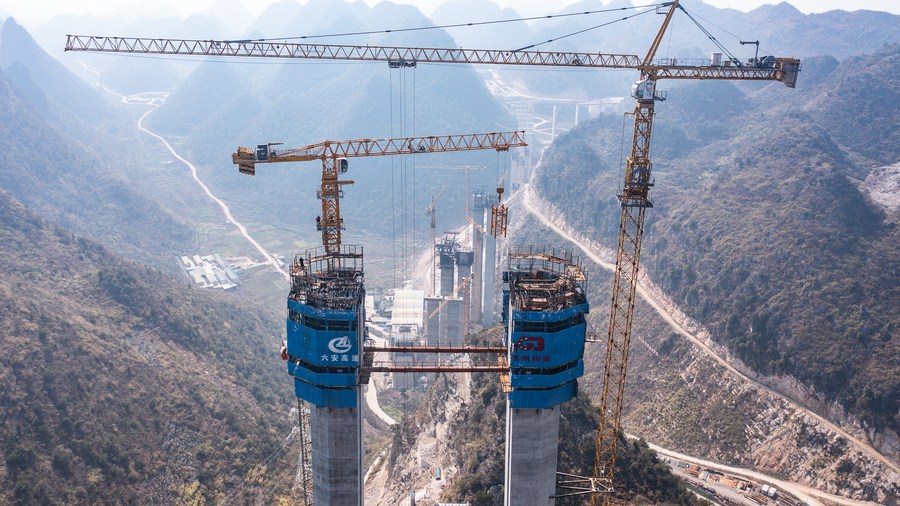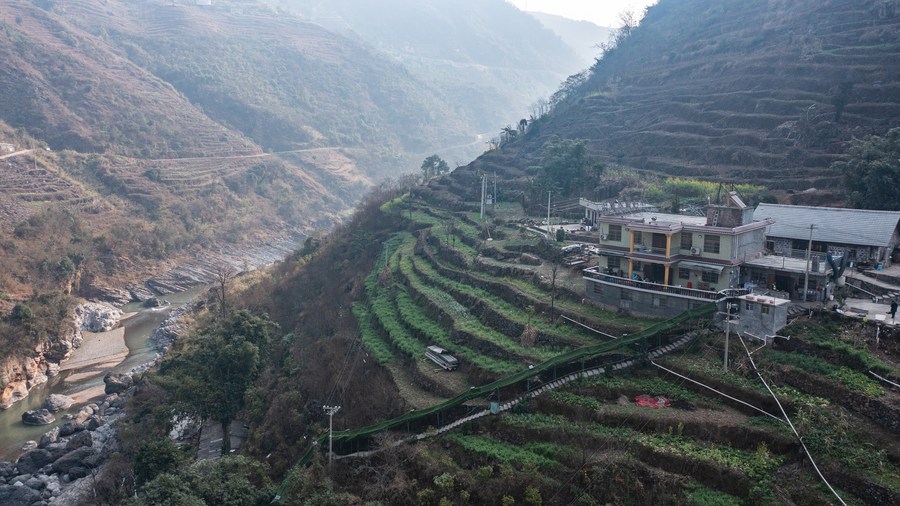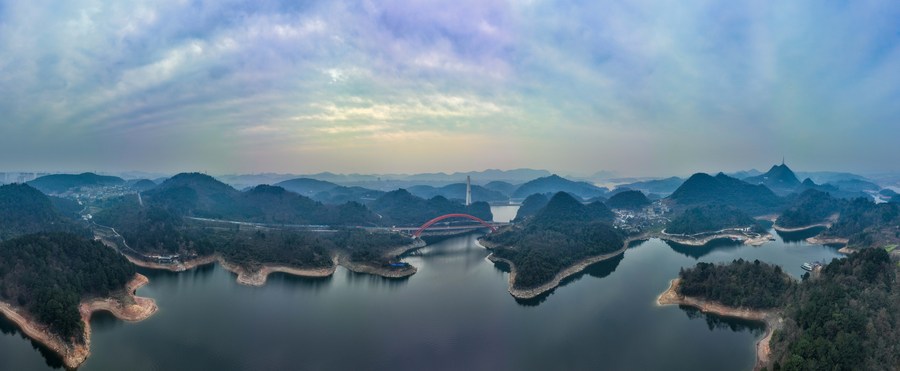Bridges bring benefits to China's mountainous province
* Bridges are an unmistakable feature of the transportation infrastructure in Guizhou. The province has built nearly 30,000 bridges since the late 1970s and is now home to nearly half of the 100 tallest bridges in the world.
* Due to the large number of bridges, their types, and the complex technologies used in the construction of the bridges, Guizhou is known as "the museum of world bridges."
* Bridges witness the leapfrog development of transport in the mountainous province. They are also a unique cultural symbol of Guizhou that represent its deepening communication with the outside world.
GUIYANG -- During the past Spring Festival holiday, a large number of tourists visited the Beipanjiang Bridge, a world record holder, in southwest China's Guizhou Province.
Sitting over 565 meters above a valley, equivalent to the height of a 200-story building, the bridge has been certified as the world's highest bridge by the Guinness World Records.
Bridges are an unmistakable feature of the transportation infrastructure in Guizhou. With 92.5 percent of its area covered by mountains and hills, the province has built nearly 30,000 bridges since the late 1970s and is now home to nearly half of the 100 tallest bridges in the world.
Thanks to the construction of bridges, the mountainous province is becoming deeply integrated with the nation's transportation network, bringing an improved quality of life for local residents.

This aerial photo taken on Feb. 10, 2023 shows the Beipanjiang Bridge on the Hangzhou-Ruili Expressway, southwest China's Guizhou Province. [Xinhua/Tao Liang]
"THE MUSEUM OF WORLD BRIDGES"
Due to the large number of bridges, their types, and the complex technologies used in the construction of the bridges, Guizhou is known as "the museum of world bridges," according to the provincial department of transport.
Above the grand canyon of Huajiang River, which features towering cliffs and fast-flowing currents, the mega project of a steel-truss girder suspension bridge is under construction.
With a vertical height of 625 meters from the bridge deck down to the water's surface, the bridge is expected to become the highest in the world after completion in 2025. It will cut the travel time across the canyon from about an hour to a mere minute.
Deep gorges, steep terrains, and the highly developed karst landscape left the project team with few choices but to design such a high bridge, said Wu Chaoming, the project manager of the bridge, adding that builders had to dig 68 meters beneath the ground to establish the pile foundation on one side to ensure its safety and stability.

This aerial photo taken on Jan. 31, 2023 shows the construction site of a bridge on the Liuzhi-Anlong Expressway over the grand canyon of Huajiang River, southwest China's Guizhou Province. [Xinhua/Tao Liang]
For bridge expert, Han Hongju, who is the chief engineer of Guizhou Communications Construction Group Co., Ltd, the height of a bridge is not the only indication of sophistication in bridge building.
"It is far more challenging to build a bridge with a long span above deep gorges in mountainous areas," said Han.
When designing the Beipanjiang Grand Bridge, another bridge over the Beipan River, in 2013, Han came up with the innovative idea of using a beam bridge to support a major span of 290 meters.
The new approach defied the norm at that time when cable-stayed and suspension bridges were the first choices to deal with spans exceeding 200 meters, even though that meant a significant rise in construction costs.
"Bigger doesn't mean better in bridge building. Being economical is also a priority. The best bridge is the one that suits its conditions," said Han.
Under his guidance, Liuzhi Bridge on Nayong-Qinglong Expressway is under construction. With a span of 320 meters, the bridge is expected to set a new record for the span of prestressed concrete beam bridges.
PATH TO PROSPERITY
In December last year, Dafa Canal Bridge was put into operation in the Zunyi City of Guizhou after four years of construction. It has made Tuanjie Village, located in the deep mountains, more accessible.
"Building the bridge in a remote area is no easy task. It's a bridge that will bring happiness and prosperity to our local residents," said Huang Dafa, former Party chief of Tuanjie Village.

Huang Dafa, former Party chief of Tuanjie Village, sits under the Dafa Canal Bridge near the village in southwest China's Guizhou Province, June 16, 2021. [Xinhua/Liu Xu]
"More people are coming to the village, and business is booming," said Wang Chaohai, the incumbent village Party chief, adding that villagers aim to take full advantage of the convenient transport to sell high-quality rice and other agricultural products.
In recent years, many bridges in Guizhou have turned out to be popular tourist attractions owning to the stunning scenery around them.
Ma Xuanjun, a farmer living near the Beipanjiang Bridge, turned his newly-built brick house into a rural inn in 2019 and started to receive tourists from afar.
"Before the bridge was built, it would take us four hours to climb over the mountain to the town seat," said Ma, as he pointed to the gliding ropes that were used to cross the river.
Now, his inn is decorated with photos he took with tourists from home and abroad.
"Many tourists visited our village for the bridge. I will do my best to make them feel happy and remember my hometown," Ma said.

This aerial photo taken on Feb. 10, 2023 shows the rural inn (R) run by Ma Xuanjun near the Beipanjiang Bridge on the Hangzhou-Ruili Expressway, southwest China's Guizhou Province. [Xinhua/Tao Liang]
Xu Xianghua, the chief engineer of the Guizhou provincial department of transport, said that bridges witness the leapfrog development of transport in the mountainous province.
Bridges are also a unique cultural symbol of Guizhou that represent its deepening communication with the outside world, Xu added.
HARMONY BETWEEN HUMANS AND NATURE
For a long time, bridge builders in Guizhou had been troubled by a lack of high-quality materials for building bridges. As the rivers in the province mainly flow from alpine gorge areas, they produce little river sand, a key material for making concrete.
Shi Dawei, the chief engineer of Guizhou Expressway Group Co., Ltd, recalled that builders had to buy high-standard river sand from Chongqing Municipality and Hunan Province, or even from foreign countries like Malaysia.
To reduce the cost of materials, builders resorted to natural mountain rocks in the province, as bridge building often involved excavating mountains. After 20 years of effort, they succeeded in developing sand-making techniques by machines.
Since 2011, a total of more than 20 million cubic meters of machine-made sand have been used in Guizhou, saving over 7 billion yuan (about 1.03 billion U.S. dollars) in construction costs. The large-scale application of machine-made sand has also reduced river sand mining, thus contributing to environmental protection.
Guizhou is an important ecological barrier in the upper reaches of the Yangtze River and the Pearl River. However, it is one of the largest areas in China that suffers from stony desertification.
Due to the fragile ecological environment, how to minimize the impact on nature has always been a top priority for bridge builders in Guizhou. The new Huayudong Bridge, built in June 2021 to replace a decades-old one, is an exemplary case in this regard.

This stitched aerial photo taken on Feb. 1, 2023 shows the Huayudong Bridge in southwest China's Guizhou Province. [Xinhua/Ou Dongqu]
As the bridge is located at a scenic spot and also a protected area for a drinking water source, the designers and builders made extra efforts to reduce the environmental impact of the project.
Instead of building the new bridge after demolishing the old one, they used the old bridge as a construction platform and transport pathway and dismantled it step by step as the project proceeded.
The new approach ensured a smoother structural transition from the old bridge to the new one, thus greater construction safety, said Yang Jian, chief designer of the project.
Last April, the Huayudong Bridge won the Gustav Lindenthal Medal, one of the most prestigious bridge construction awards in the world.
The award is a recognition of the building techniques, environmental protection efforts, and aesthetic values of the Huayudong Bridge project, said Yang.
Video reporters: Wu Siyang, Liu Qinbing, Yang Yanbin, Wu Si; Video editors: Tang Jingyao, Yin Le, Wang Houyuan, Zhu Cong, Liu Xiaorui
























